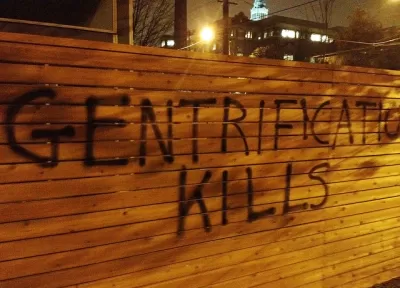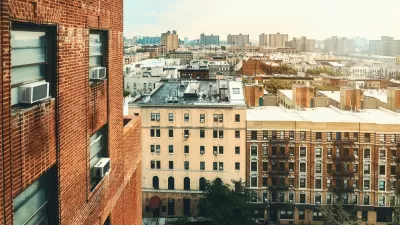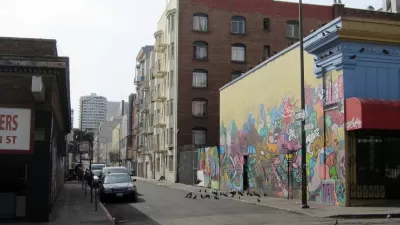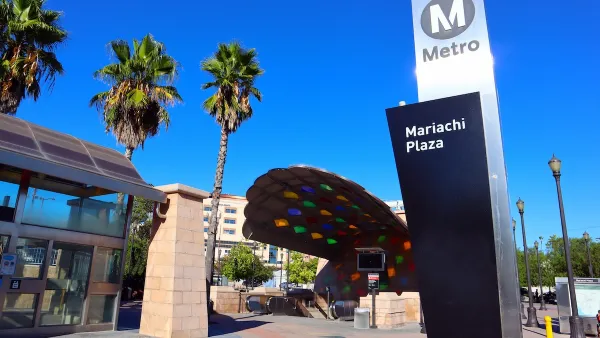The income of original residents is more important to the gentrification debate than any opposition to luxury development or price controls. We need to begin to embed income inequality within the gentrification debate.

Over the years, I have developed a reputation among my more progressive friends (for the record, I consider myself a left leaning moderate Democrat) of being rather pro-development (they view that as a bad thing). In fairness to them, I am relatively pro-development in most cases. However, this same reputation has led to several heated arguments about gentrification (any good friend of mine can hold their own in an argument). More specifically, I have been accused of being a proponent of gentrification, and by that they mean I seem to be in favor of kicking poor people out of existing communities. Of course, that’s a bit of an exaggeration, not to mention completely untrue. Yet while many of my friends will debate vigorously the topic of development and gentrification, none have ever asked for my views on topics like minimum wage in the same debate, and I don’t understand why.
Gentrification is far more complicated than we are willing to discuss in casual conversation—an interplay of development policies, job availability, income inequality, access to transportation, and migration. While each is worthy of discussion, perhaps the most important of all of them is the income of original residents. Focusing only on development projects and price controls simply perpetuate a false choice between development and non-development while doing nothing for the very bloc of residents activists claim to represent. We need to start talking more about wages and income of original residents in the context of urban development and gentrification instead of as some separate or loosely related topic.
What is Gentrification Anyway?
We all think we know gentrification. Generally speaking, the process of gentrification is often described as resulting from two primary effects. The first is that new policies and development result in an increase in property values and cost of living within an existing urban neighborhood. The second is a population migration characterized as an in-migration of new residents—usually white, middle, and upper-class (hence “Gentry”)—followed by the out-migration of the original residents, often lower-income. The resulting mix of migration patterns ultimately changes the culture and character of the neighborhood.
The problem with this common narrative is not that it’s incorrect. The steps described are accurate, but the issue is that the narrative finds a simplistic causation between development and out-migration. I don’t believe there is one, at least not directly. Further, by finding that simplistic causation, the narrative sets up the false conclusion that to be “pro-development” is to, in turn, push the out-migration of original lower-income residents, leading to the vilification of urban development and developers as well as the use of economically inefficient price controls. Once we begin to accept that gentrification is more complicated than a single cause followed by effect, we then can and should begin to ask what else is at play in the process and begin to see causation from income rather than development itself.
Gentrification at Work
Property values do not occur in a vacuum. Put very simply, as investment occurs in a neighborhood—new development, streetscape improvements, etc.—the property (or neighborhood) attracts more demand and property values rise. As values rise, so do the costs associated with the property. If you own the property your property tax may increase making the simple act of owning the home more expensive. If you are renting a unit in the building your rent may increase because the property owner can pass the additional cost of owning the property onto the tenants. The property owner can also chose to sell the property altogether if he or she believes it is in their individual self-interest to do so.
As property values and aesthetics of the neighborhood change, buyers who are able to afford the increasing cost of property buy in to the neighborhood. They purchase homes at increased values following the initial investment, which in turn begins to establish the new higher average price for housing in the neighborhood, further cementing increased housing costs. As the population of higher-income resident increase, new ancillary facilities (restaurants, cafes, shops, etc.) begin to open in the neighborhood, catering to the tastes and, more importantly, income levels of the new residents.
Ultimately, the original tenants or owners in the neighborhood will likely be displaced to another low-income neighborhood (or out of the city entirely) because their income has not kept pace with rising costs and values, therefore they can’t afford the new rent or payments in whatever new or improved units that follow, let alone the new ancillary facilities.
Activists claim they've addressed the inability of low-income residents to afford a home through affordable housing requirements in new developments and price controls. The belief is that by artificially lowering the cost of new housing they make housing more affordable to original residents. However, missing in this claim is that development requirements and price controls are inefficient and the income of the original residents is more important than whether there is rent control or a city requires 20 percent or 30 percent affordable housing in new development. This inefficiency is best explained in the difference between “cheap” and “affordable” housing, and incomes involvement in both.
Affordable Housing vs. Cheap Housing
Colloquially, “affordable housing” (lower case) simply means what it says: housing that is affordable to whoever wants it, usually mid- to low-income residents and families. However, “Affordable Housing” (upper case) is a defined term in planning and development policy. The specifics can vary from state to state or city to city, but Affordable Housing refers to housing that is made available (sale or rent) by means of capping its cost to a set percentage of the area’s median income (AMI). For example, in San Francisco, an on-site Affordable Housing unit must be made available to those making 55 percent of AMI (SFMC Sec. 415.3 Table 415.3)
Cheap housing, on the other hand, has no set definition. It is housing usually in a neglected neighborhood primarily occupied by low-income residents and families who are unable to afford any alternative. It is cheap because it is old and neglected. Of course, because of cheap housing’s low property value, it is often the most desirable for redevelopment purposes. This may draw the ire of many activists, but it’s important to note here that no new development, including Affordable Housing units, will ever be as affordable as the cheap housing it’s replacing. In fact, this is such an important point that I feel it needs its own quotation:
“It’s important to note here that no new development, including Affordable Housing units, will ever be as affordable as the cheap housing it’s replacing.”
We again return to our false choice. If all development results in more expensive housing than what was originally present, then our options are investment or no investment. This shouldn't be and is not the case. Can we have development without displacement? This question has been asked before because no matter your opinion on gentrification, I’m willing to wager that you concede the first effect of the process—increase in neighborhood investment—does improve the physical environment of a neighborhood.
I’ve been to many community meetings and had many discussions with anti-gentrification activists who do want to see the neighborhoods in question improve. They believe that all neighborhoods deserve a nice streetscape and well-kept homes. In fact, the very question of “can there be development without displacement” concedes that development is inherently good, or at the very least, neutral. I mean, who doesn’t want everyone to live in a thriving and safe neighborhood? But demanding such improvements while deriding gentrification purposely refuses to accept how we assign monetary value to real estate, which in turn refuses to acknowledge how gentrification actually happens to begin with. (There is a great post from CityLab about how there is no way not to be a gentrifier in your neighborhood.)
Income and Gentrification
Income is far more important than any development requirement or price control in terms of gentrification and its effects. Alexis Stephens wrote a great post for Next City that speaks to the income aspect of the gentrification process. In the post, Stephens writes:
“In the Bay Area, more than 1.1 million workers, over one-third of the region’s workers, earn less than $18 an hour. According to the [SPUR] report, ‘lower-wage workers face significant barriers to higher-wage employment.’”
[updated*] If the AMI for a single resident in San Francisco is $68,000, new Affordable Housing will be rented out for people making 55 percent of AMI, or those making a little more than $37,000 annually (see San Francisco Max Income by Household). This means that the unit can be marketed only at 33% of this income, which comes out to around $12,000, or $1,000 per month rent. At $18 per hour, a person working full time is making a little over $37,000 before taxes, barely meeting income requirements for on-site Affordable units. A $1,000 per month may be reasonable, but such requirements risk becoming burdensome to developers as market-rate prices rise, but more importantly, it’s impossible to force the needed number units demanded through this type of development regulation, since it 1) represents only a percentage of the units built in the development (12 percent in San Francisco) and 2) because of the vilification of development and developers, projects risk being rejected outright, thus making it less likely the small percentage of units will be built to begin with.
If your response to this is simply to increase the number of affordable housing units a new development is required to provide, say to 50 percent of all units, then I ask you consider my previous post on land use controls. Such a requirement would likely be struck down by the courts as unconstitutional.
Nevertheless, no matter what political or ideological side you fall on, we all should admit that forcing any person to dedicate a high percentage of their income to housing is ridiculous. However, no cap on rent or sale price is going to address the underlying issue of an individual’s stagnate income. Simply decreasing the percentage of AMI to redefine what is Affordable Housing risks only shifting the burden to even more of the population by increasing market rate housing costs, while still avoiding the issue of income.
Moreover, leaving income inequality as a debate distinct from gentrification opens the door to misunderstanding income levels of a neighborhood in general. As gentrification plays out and higher-income residents move into a neighborhood, the average income of the neighborhood increases in part because original low-income residents are replaced by higher-income residents, thus reducing the overall pool of low-income residents contributing to the neighborhood average. By separating the two topics, we allow ourselves to use rising income levels of a neighborhood as a measure of success, rather than fully understanding where that rise came from.
Need to Include Income in Gentrification Debate
As I mentioned at the outset, I have a strong and developed belief we need to build more and you are welcome to take my views with whatever skepticism you prefer, but neglecting to thoughtfully include the topic of income makes our present debate over gentrification a straw man for the real issue, and one most are oddly content to continue. We should not separate the issue of income (and income inequality) from gentrification, nor should we blindly make development and developers the villain. Fighting over the construction of much needed new development, the required percentage of Affordable Housing units, or price controls at best sidelines a necessary and relevant conversation, and at worst completely ignores the very issue that ultimately causes the effect of neighborhood displacement.
Wages are still incredibly low for the recovering economy. Raising the minimum wage, increasing pay overall for most workers (pay in general for workers has not kept with inflation, let alone grown), ensuring equal pay for women, providing an adequate funding for assistance programs, and many other programs that directly address how much money individuals and families bring in will do far more to mitigate the negative effects of gentrification than any onerous development requirement or price control ever will. To focus solely on development is missing the forest because of the trees and only ensures that neighborhoods in much need of investment go without.
Perpetuating this false choice between development and non-investment only hurts the effort to build consensus around a solution that actually solves the underlying problem of income and cost of living.
*Update made on October 28, 2014. Post originally made incorrect calculations on affordability requirements.

Planetizen Federal Action Tracker
A weekly monitor of how Trump’s orders and actions are impacting planners and planning in America.

Map: Where Senate Republicans Want to Sell Your Public Lands
For public land advocates, the Senate Republicans’ proposal to sell millions of acres of public land in the West is “the biggest fight of their careers.”

Restaurant Patios Were a Pandemic Win — Why Were They so Hard to Keep?
Social distancing requirements and changes in travel patterns prompted cities to pilot new uses for street and sidewalk space. Then it got complicated.

California Homeless Arrests, Citations Spike After Ruling
An investigation reveals that anti-homeless actions increased up to 500% after Grants Pass v. Johnson — even in cities claiming no policy change.

Albuquerque Route 66 Motels Become Affordable Housing
A $4 million city fund is incentivizing developers to breathe new life into derelict midcentury motels.

DC Area County Eliminates Bus Fares
Montgomery County joins a growing trend of making transit free.
Urban Design for Planners 1: Software Tools
This six-course series explores essential urban design concepts using open source software and equips planners with the tools they need to participate fully in the urban design process.
Planning for Universal Design
Learn the tools for implementing Universal Design in planning regulations.
Heyer Gruel & Associates PA
JM Goldson LLC
Custer County Colorado
City of Camden Redevelopment Agency
City of Astoria
Transportation Research & Education Center (TREC) at Portland State University
Camden Redevelopment Agency
City of Claremont
Municipality of Princeton (NJ)






























